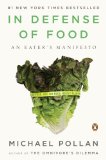Summary | Excerpt | Reviews | Beyond the Book | Readalikes | Genres & Themes | Author Bio

Critics' Opinion:
Readers' Opinion:
First Published:
Jan 2008, 256 pages
Paperback:
Apr 2009, 256 pages
 Book Reviewed by:
Book Reviewed by:
Lucia Silva
Buy This Book
In the years following the 1977 Dietary Goals and the 1982 National
Academy of Sciences report on diet and cancer, the food industry, armed with its
regulatory absolution, set about reengineering thousands of popular food
products to contain more of the nutrients that science and government had deemed
the good ones and fewer of the bad. A golden age for food science dawned.
Hyphens sprouted like dandelions in the supermarket aisles: low-fat,
no-cholesterol, high-fiber. Ingredients labels on formerly two- or
three-ingredient foods such as mayonnaise and bread and yogurt ballooned with
lengthy lists of new additives — what in a more benighted age would have been
called adulterants. The Year of Eating Oat Bran — also known as 1988 — served as
a kind of coming-out party for the food scientists, who succeeded in getting the
material into nearly every processed food sold in America. Oat bran's moment on
the dietary stage didn't last long, but the pattern now was set, and every few
years since then, a new oat bran has taken its star turn under the marketing
lights. (Here come omega-3s!)
You would not think that common food animals could themselves be rejiggered to
fit nutritionist fashion, but in fact some of them could be, and were, in
response to the 1977 and 1982 dietary guidelines as animal scientists figured
out how to breed leaner pigs and select for leaner beef. With widespread
lipophobia taking hold of the human population, countless cattle lost their
marbling and lean pork was repositioned as "the new white meat" — tasteless and
tough as running shoes, perhaps, but now even a pork chop could compete with
chicken as a way for eaters to "reduce saturated fat intake." In the years since
then, egg producers figured out a clever way to redeem even the disreputable
egg: By feeding flaxseed to hens, they could elevate levels of omega-3 fatty
acids in the yolks.
Aiming to do the same thing for pork and beef fat, the animal scientists are now
at work genetically engineering omega-3 fatty acids into pigs and persuading
cattle to lunch on flaxseed in the hope of introducing the blessed fish fat
where it had never gone before: into hot dogs and hamburgers.
But these whole foods are the exceptions. The typical whole food has much more
trouble competing under the rules of nutritionism, if only because something
like a banana or an avocado can't quite as readily change its nutritional
stripes. (Though rest assured the genetic engineers are hard at work on the
problem.) To date, at least, they can't put oat bran in a banana or omega-3s in
a peach. So depending on the reigning nutritional orthodoxy, the avocado might
either be a high-fat food to be assiduously avoided (Old Think) or a food high
in monounsaturated fat to be embraced (New Think). The fate and supermarket
sales of each whole food rises and falls with every change in the nutritional
weather while the processed foods simply get reformulated and differently
supplemented. That's why when the Atkins diet storm hit the food industry in
2003, bread and pasta got a quick redesign (dialing back the carbs; boosting the
proteins) while poor unreconstructed potatoes and carrots were left out in the
carbohydrate cold. (The low-carb indignities visited on bread and pasta, two
formerly "traditional foods that everyone knows," would never have been possible
had the imitation rule not been tossed out in 1973. Who would ever buy imitation
spaghetti? But of course that is precisely what low-carb pasta is.)
A handful of lucky whole foods have recently gotten the "good nutrient"
marketing treatment: The antioxidants in the pomegranate (a fruit formerly more
trouble to eat than it was worth) now protect against cancer and erectile
dysfunction, apparently, and the omega-3 fatty acids in the (formerly just
fattening) walnut ward off heart disease. A whole subcategory of nutritional
science — funded by industry and, according to one recent analysis,* remarkably
reliable in its ability to find a health benefit in whatever food it has been
commissioned to study — has sprung up to give a nutritionist sheen (and
FDA-approved health claim) to all sorts of foods, including some not ordinarily
thought of as healthy. The Mars Corporation recently endowed a chair in
chocolate science at the University of California at Davis, where research on
the antioxidant properties of cacao is making breakthroughs, so it shouldn't be
long before we see chocolate bars bearing FDA-approved health claims. (When we
do, nutritionism will surely have entered its baroque phase.) Fortunately for
everyone playing this game, scientists can find an antioxidant in just about any
plant-based food they choose to study.
Excerpted from In Defense of Food by Michael Pollan. Reprinted by arrangement with The Penguin Press, a member of Penguin Group (USA), Inc. Copyright (c) Michael Pollan, 2008.





The Funeral Cryer by Wenyan Lu
Debut novelist Wenyan Lu brings us this witty yet profound story about one woman's midlife reawakening in contemporary rural China.
Your guide toexceptional books
BookBrowse seeks out and recommends the best in contemporary fiction and nonfiction—books that not only engage and entertain but also deepen our understanding of ourselves and the world around us.